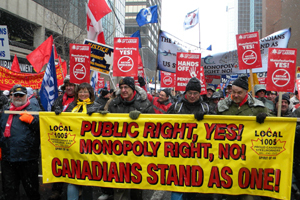Canadians Rally to Defend Pensions in U.S. Steel Lockout

As many as 10,000 unionists and supporters converged on downtown Hamilton, Ontario, to support locked-out Steelworkers and decry their employer, U.S. Steel, for failing to honor its commitments. They also brought tens of thousands of dollars in donations for the union’s defense fund, from public employee and private-sector unions alike.
The Saturday gathering was the biggest rally in the community since the one-day citywide strike in 1996 during Ontario’s Days of Action. Attendees bused in from as far away as Montreal, almost 400 miles distant, to voice an angry cry at the federal government’s inaction.
USW Local 1005 has been locked out of the Hamilton Works since November 7. They have refused to bend to concessions demanded by U.S. Steel that they give up the indexing of pensions to inflation, and discontinue the defined benefit pension plan for new hires. The local has only asked that a status quo agreement be maintained.
Larry Perrins, 75, retired in 1993 after 37.5 years on the job. He came to the rally Saturday not just to defend his own pension but to protect newer workers—including his son.
Indexing has boosted Perrins’ pension slowly from $1000 a month when he retired to $1366, ensuring that he kept up as the cost of living rose.
“Whatever it takes, this is one fight we have to win,” he said. “We cannot afford to let these companies walk all over us.”
The federal government gave its approval for U.S. Steel to buy the former Stelco in 2007. To get that approval it promised a “net benefit” to Canada by maintaining jobs and production for three years. Within two years, however, the company’s Hamilton area plants had been shut down twice, their work transferred to American mills. About 2,200 workers were laid off, and only 900 remained to be locked out in November.
“With the current state of the steel market right now there is no reason why we should be closed whatsoever,” said Glen Anderson, an 11-year veteran of the Hamilton Works. “There is a demand for steel all across this country.”
While U.S. Steel posted a loss last year, its shipments increased by 50 percent as demand picked back up.
The government alleges the company has breached the terms of its “net benefit” agreement—whose details have not made available to the public or the union. The federal government sued a year ago, and courts could yet impose $10,000-a-day fines. The union has called on the government to force U.S. Steel to sell the plant if it is found to have broken its commitments.
U.S. STEAL

SUPPORT LABOR NOTES
BECOME A MONTHLY DONOR
Give $10 a month or more and get our "Fight the Boss, Build the Union" T-shirt.
Local 1005 retiree Vern McDonald rode the train in from 20 miles outside town to attend the rally, which took place in a 24-degree chill and snow flurries. He said he always believed the union should bargain increases to the pension so members would have security in their old age.
“I weathered the cold to stand up for what I think is right,” McDonald said. “Our government should stand behind us and not allow these companies to come in here and try to opt out of what was agreed to. We worked for it, we earned it, and it’s ours!”
About 25 percent of Canadians working in the private sector have an employer-provided defined benefit pension plan. (In the U.S., by contrast, about one-sixth of private-sector workers have such plans).
“We went through two or three strikes and gave up on wage demands to get these benefits,” said McDonald, 63, who has been retired for 10 years. “I thought that our pension agreements would still stand regardless of who owned the mill.”
The rally came together with the assistance of the Ontario Federation of Labour and the Hamilton and District Labour Council, and speaker after speaker denounced the conservative government of Stephen Harper for allowing the sale of Stelco.
The union celebrated a recent decision by the federal unemployment agency to grant about 40 weeks of unemployment insurance benefits, about $403 a week, to the locked-out members. This is in addition to the $200-a-week lockout pay received from the Steelworkers.
U.S. Steel lost on appeal mainly because it had effectively shut down operations due to a lack of work one month prior to locking out the workers, and because workers never voted on the company’s final offer or to go on strike.
The company has tried to sow divisions between current workers and retirees, betting that 900 members would take a deal and throw the plant’s 9,000 retirees overboard. When the local didn't put the concessions to a vote, the company locked them out. The strategy has failed, locked-out members said on Saturday.
“We want our jobs back but not at the expense of our pension and benefits,” Anderson said.
Mike Williams is a member of Steelworkers Local 16506 in Hamilton and a machinist at John Crane, which makes mechanical seals for the oil and gas industry. His local will probably face the same pension demands as Local 1005 in August bargaining.






You must log in or register to post a comment.